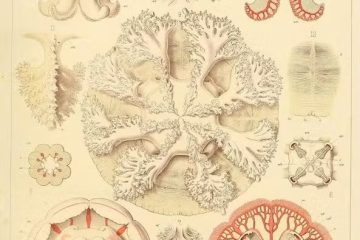“J” is for Nothing: Oppenheimer’s, Nolan’s, and My Enchantments

In the Land of Enchantment
My interest in J. Robert Oppenheimer began in earnest around 1990 when, as a graduate student in History and Philosophy of Science, I enrolled in a seminar intriguingly titled “Big Science.” Historians commonly trace the advent of Big Science to the Manhattan Project, but the term also encompasses such large-scale endeavors as the Hubble Space Telescope, The Human Genome Initiative, and giant particle accelerators. Its hallmarks include, in a handy mnemonic, “money, manpower, machines, media, and the military.” Compartmentalization of research, encouraged by Big Science, enabled new compromises and trade-offs, both moral and practical, and the diffusion of responsibility for the end products.
My seminar paper proposed to illustrate how the turn to myth and religion in the rhetoric surrounding the Manhattan Project—particularly, Oppenheimer’s often oracular pronouncements—effectively shielded the physicists from culpability for their creation. I compiled stacks of color-coded index cards scribbled with notes and damning quotes, but struggled to fix my argument in my own head or articulate it to an imagined reader. In the end, I gratefully accepted an incomplete in the course. Later, I dropped out of the program altogether. Yet, by the grace of a fortuitous registrarial glitch, the incomplete never lapsed into an F. Decades on, my transcript still records that ambiguous, non-punitive “I.” It is a fitting symbol of my ongoing preoccupation with the atom bomb. (I would end up finishing the paper a quarter-century later.) 
By the late 1990s, I was a doctoral student in Religious Studies, working to redeem the sins of my academic past. A cross-country honeymoon trip took me to the “Land of Enchantment” itself, New Mexico. Topping the list of romantic destinations were two Big Science attractions: the prosaically named Very Large Array radio telescope facility near Socorro, New Mexico (featured in the religion and science-themed film Contact) and the atomic bomb museum at the Los Alamos National Laboratory. Like many museum visitors, but perhaps few newlyweds, we posed for photos with replicas of Little Boy and Fat Man, the bombs dropped on Hiroshima and Nagasaki, respectively.
Later, we hiked through nearby Bandelier National Monument, touring the ancient ruins and ingenious cliff dwellings built by the Ancestral Puebloans. We marveled at the durability of the curious stone structures and the fragility of civilization. The marriage, also fragile, disintegrated a few years later, for reasons that are almost entirely my fault. But the trip instilled in me an enduring love of the Western sublime, and the haunting and haunted landscape of New Mexico.
Oppenheimer’s Enchantments
Oppenheimer loved New Mexico too—loved it enough to risk incinerating it (paradox, in case you missed it, is an abiding theme of Christopher Nolan’s film Oppenheimer.) He and his brother Frank, also a contributor to the bomb project, owned a ranch there. Both were avid outdoorsmen. As Nolan’s film reminds us, Oppenheimer dreamed of somehow uniting physics and New Mexico, his two great passions.
His dream became a nightmare for the rest of the world, but especially for those subjected to the awesome power of “The Gadget.” Leading up to the Trinity Test on July 16, 1945, Manhattan Project leaders, wary of arousing suspicion and panic, decided against evacuating New Mexicans in the Tularosa Basin, a flat, arid expanse between two mountain ranges. When the bomb was detonated in the Alamogordo desert in early dawn, the blast was visible 160 miles away. Some residents believed the world was ending. As one witness recalls, “they started praying like crazy … to Santa Rita or whoever ‘cause they thought, the sun’s coming up on the wrong side of the world.” Rita is the patron saint of impossible causes. Her specialties include sickness, wounds, abuse, and sterility.

Members of the Tularosa Downwinders Consortium protest near the Trinity Site during an open-house event at the site. Tularosa Downwinders Consortium
Hundreds of Trinity’s “downwinders” would succumb to radiogenic illness, never—yet—to receive restitution. Rural New Mexicans lived close to the land. Many collected rainwater to drink, grew vegetables, and raised animals for food, humble practices that increased their radiation exposure and incidence of cancer and stillbirth. While Oppenheimer dramatizes the physicist’s struggles with his conscience, it neglects the—completely avoidable—misery and death that spread through the backcountry with which he was so enchanted.
Nolan’s Enchantments
The film’s portrait of Oppenheimer foregrounds standard themes of sin, temptation, evil, punishment, and other mythic mash-ups that drew me to this story decades ago. The film opens, predictably, with a nod to Prometheus whose gift of fire was met with eternal punishment. Within minutes, in the first on-screen encounter between the celebrated physicist Niels Bohr and an earnest but crafty young Oppenheimer, the biblical allusions start piling up. A tempting but dangerous apple. Obscure references to serpents. In an impulsive bid to exact revenge on his authoritarian Cambridge tutor, Oppenheimer has secretly injected an apple with cyanide. Bohr edges toward the apple. Just as he is about to take a bite, Oppenheimer snatches it and hurls it away. The incident foreshadows Oppenheimer’s temptation by an even greater evil. As viewers already know, he will succumb to it. Dark secrets—Oppenheimer’s own and those of the atom—will be revealed. “You can’t lift the stone without being ready for the snake that’s revealed,” Bohr cryptically observes. Later Oppenheimer will recite the aphorism back to him.
Nolan’s characteristically nonlinear narrative is anchored by repetition of certain prophetic utterances like these. Oppenheimer’s much discussed Bhagavad Gita-inspired proclamation, “Now I am become Death, destroyer of worlds,” similarly appears twice. Oppenheimer claimed that the text sprang to mind with the successful detonation at the Trinity Site. Commentators have offered various interpretations over the years, some arguing that Oppenheimer embraced in that moment the divine world-destroying power of Krishna, others identifying him with Arjuna, the diligent student and reluctant warrior of the epic poem. At times Nolan seems to entertain the sympathetic portrait, as when Oppenheimer’s wife, Kitty, repeatedly implores him to stand up to the vain and petty bureaucrats bent on his destruction: “Why won’t you fight?” The unwilling world-destroyer, Nolan hints, was in the end destroyed by the world.
But Nolan also plants this disturbing bit of Hindu scripture in less likely places. In an almost too-intimate scene between Oppenheimer and his capricious paramour, Jean Tatlock, she orders him to translate the noted lines of the Bhagavad Gita while she straddles him. The suggestion here is of the seductive allure of death-dealing powers (and of Oppie himself). Tatlock committed suicide at the age of 29. Nolan portrays Oppenheimer as afflicted by turns with visions of her death and images of the bomb’s hideous aftermath. Dynamics of temptation and death, passion and destruction, forbidden fruit and punishment, define the physicist’s heated pursuits. Kitty makes the connection for us: “You don’t get to commit sin, and then ask all of us to feel sorry for you when there are consequences.”
Nolan makes less of the motif of sin than he might. He does not dwell on Oppenheimer’s equally famous assertion, issued on more than one occasion, that the atomic scientists had “known sin.” Oppenheimer alluded to the irresistible pull, the “technically sweet” enticements, of nuclear fission. “It is my judgment in these things,” he explained in one of his less poetic moments, “that when you see something that is technically sweet you go ahead and do it and you argue about what to do about it only after you have had your technical success.”

J Robert Oppenheimer and Gen Leslie Groves at Ground Zero, September, 1945. Credit: Digital Photo Archive, Department of Energy (DOE), courtesy AIP Emilio Segre Visual Archives
You go ahead and do it. Enchantment with the technical puzzle overcame moral qualms, even against the backdrop of shifting and increasingly inadequate rationales for the weapon’s creation. Oppenheimer often spoke of the bomb in two distinct registers: an astonishing technical success, an appalling moral lapse. Compartmentalization—another recurring theme in Oppenheimer—split the physicist into myriad parts, like the atom. Physicist I.I. Rabi, a close friend of Oppenheimer’s, understood him as “put together of many bright shining splinters.” A man without a solid core.
The Disenchantment of the World
Identity was a problem for Oppenheimer. The New York Times obituary that ran when Oppenheimer succumbed to throat cancer at the age of 62 refers to him as “J. (for nothing) Robert Oppenheimer.” He often insisted that his first initial indeed stood for nothing. Fittingly for one so enigmatic, the historical record can neither confirm nor deny this. More than 50 years after his death, it remains difficult to discern what Oppenheimer did and did not stand for. Though Nolan sometimes tips his hand, Oppenheimer resists any final resolution of the paradox.
Today, the world’s relationship with nuclear weapons seems one of anxious suspended animation, like an incomplete grade that has somehow evaded the punishing finality of failure. After viewing the film, my son commented that the logic of mutual deterrence seems to be working. After all, here we are. But recent world events and renewed, careless talk of “tactical” nuclear weapons highlight the fragility of this arrangement. Meanwhile, at the start of this year, atomic scientists moved the hands of the Doomsday Clock to 90 seconds before midnight, the closest the world has ever been to the threat of annihilation.
#
Lisa H. Sideris is Professor of Environmental Studies at UC Santa Barbara. Before coming to UCSB, she taught in the Religious Studies Department at Indiana University, the Faculty of Religious Studies and School of the Environment at McGill University in Montreal, and the Department of Philosophy and Religious Studies at Pace University in New York City. She teaches a variety of courses in environmental ethics, science and religion, and nature spirituality, as well as courses focused on the emerging ethical issues of the Anthropocene. She is author of Environmental Ethics, Ecological Theology, and Natural Selection, and Consecrating Science: Wonder, Knowledge, and the Natural World, and co-editor of a collection of interdisciplinary essays on the life and work of environmental pioneer Rachel Carson, titled Rachel Carson: Legacy and Challenge.
This blogpost was first published on APRIL Online on 6 August 2023. Republished with permission.
Counterpoint blogs may be reprinted with the following acknowledgement: “This article was published by Counterpoint: Navigating Knowledge on 29 August 2023.”
The views and opinions expressed on this website, in its publications, and in comments made in response to the site and publications are those of the author(s) and do not necessarily reflect the views and opinions of Counterpoint: Navigating Knowledge, its founders, its staff, or any agent or institution affiliated with it, nor those of the institution(s) with which the author is affiliated. Counterpoint exists to promote vigorous debate within and across knowledge systems and therefore publishes a wide variety of views and opinions in the interests of open conversation and dialogue.



